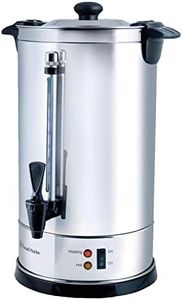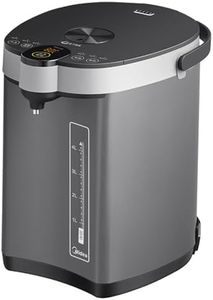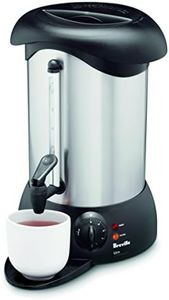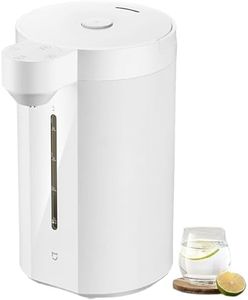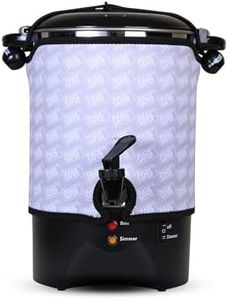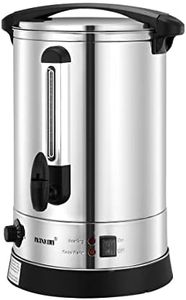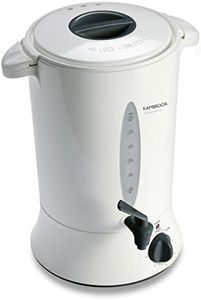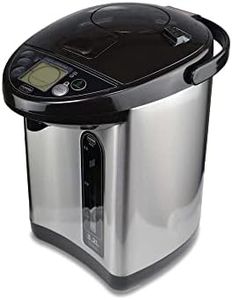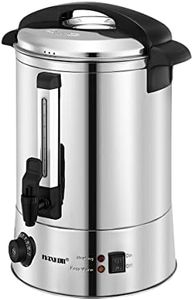We Use CookiesWe use cookies to enhance the security, performance,
functionality and for analytical and promotional activities. By continuing to browse this site you
are agreeing to our privacy policy
10 Best Electric Urns
From leading brands and best sellers available on the web.By clicking on a link to a third party's website, log data is shared with that third party.
Buying Guide for the Best Electric Urns
When choosing an electric urn, it's important to focus on how you'll use it—are you looking to serve many people at an event, or do you need something more compact for smaller gatherings or offices? Consider the frequency of use, what drinks you'll be heating (water, tea, coffee), and how portable or permanent you need the urn to be. By thinking about your typical use-case, you’ll make a better decision and avoid regrets. It’s also wise to look at safety and maintenance features for peace of mind and ease of use.CapacityCapacity tells you how much liquid the urn can hold, usually measured in liters or gallons. It's important because it determines how many cups you can serve at once. Small urns (around 3-5 liters) are great for small groups or offices, while medium sizes (6-10 liters) work well for larger meetings or community events. Large urns (over 10 liters) are best for big gatherings or regular heavy use. You should consider how many people you'll serve on a typical occasion, so you get enough volume without unnecessarily taking up space or wasting energy.
Heating Element Power (Wattage)Wattage is a measurement of how powerful the urn’s heating element is, which affects how quickly it heats up the liquid and keeps it warm. Lower wattage (up to 1000W) means slower heating and is usually found in smaller urns, suitable when immediate speed isn’t crucial. Medium (1000-1500W) is balanced for average needs, heating moderately quickly and maintaining temperature well. High wattage (over 1500W) is great for large urns or situations where fast boiling is important, like at busy events. Think about how quickly you need your beverage ready and how often you’ll be refilling the urn.
Temperature ControlTemperature control indicates whether you can adjust how hot the water or beverage gets, or if it simply keeps it at boiling. Some urns have a simple on/off boiling function, but many offer adjustable thermostats or multiple settings. Basic urns usually just boil and keep hot—suitable for tea or hot water. More advanced ones let you choose lower temperatures, which is useful for coffee or delicate teas. Consider the drinks you’re preparing; if you only need hot water, a basic option is fine. If you want to serve different beverages at ideal temperatures, look for urns with adjustable controls.
Dispensing MechanismThe dispensing mechanism is about how you get liquid from the urn. There are basic push-button or lever spouts and sometimes hands-free or cup-touch options. Simple spouts work for most basic needs, but if you expect lots of use or need extra hygiene (like public events), consider mechanisms that minimize contact. If accessibility is important, look for easy-to-use levers that don’t require much strength or coordination. Your choice should reflect how, where, and by whom the urn will be used most frequently.
Build MaterialBuild material usually refers to the inner and outer surfaces—most commonly stainless steel or sometimes plastic. Stainless steel urns are more durable, often look better, and are easier to clean, which makes them ideal for frequent or heavy use. Plastic models tend to be lighter and sometimes cheaper, but might not keep drinks as hot for as long and can be less robust. Consider where you’ll place the urn—if it needs to look professional or withstand a lot of use, steel is usually preferable. For light, infrequent, or mobile use, a quality plastic urn could be a simpler choice.
Safety FeaturesSafety features include things like automatic shut-off, boil dry protection, cool-touch exteriors, and lockable lids. These are important to prevent accidents or damage, especially in busy or public environments. If you’re concerned about unattended operation or children being nearby, prioritize safety features. Frequent users or event organizers should look for robust safety systems to minimize risk.
Ease of CleaningEase of cleaning means how simple it is to empty, rinse, and clean the urn. Some urns have removable lids and wide openings for easy access, while others may have nonstick coatings inside to prevent scale build-up. If you plan to use the urn often, easy cleaning will save time and prevent off-flavors from residues. If you’ll only use it occasionally, a simpler design could be fine. Think about whether you’ll need to dismantle parts or if you want a model that’s trouble-free after heavy use.
